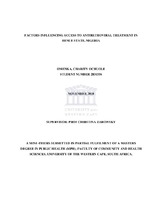| dc.description.abstract | At the end of 2008, Nigeria had the third largest number of people living with HIV/AIDS(PLWHA) in the world, with an estimated 2.95 million people and an average prevalence rate of 4.6%. According to the 2008 prevalence survey, prevalence rates in Nigeria’s 36 states and capital ranges between 1.0% in Ekiti State, to 10.6% in Benue.In Benue State, as at December 2008, only 12% of those requiring treatment were enrolled in an ART programme and only about half of the 23 Local Government Areas (LGAs) had a health centre providing ART services. There are several possible causes for poor coverage of ART services. This study explores some of the barriers preventing PLWHAs from accessing treatment
in Benue State.The study utilized a qualitative case study design to explore the problem of poor access to ART in Benue State. PLWHAs, policy makers, program managers and health workers were involved in an effort to describe the factors influencing access to ART in the State. Semi structured interviews, exit interviews and focus group discussions were used.To analyse the findings, categorization was done into facilitators and barriers to access, in addition to the ways respondents believe these barriers can be overcome. Other sub-themes were also identified and sorted. Themes were linked to direct quotes from the respondents. Additional literature review was done to review available information on the themes identified.
Facilitators of access included free cost and increased number of sites; beneficial effects of ART;disclosure, membership in a support group and having a treatment partner. Barriers included stigma and discrimination; hunger, poverty, transportation and opportunity costs; hospital factors; non-disclosure; inaccurate knowledge and perceptions about HIV and ART; certain religious beliefs and advice; coverage, capping of services and fear of non-availability of ART.In addition to stigma, patients bypass closer ART access points to further away hospitals because of business opportunities; financial assistance; perceived better standard of care and hope that a cure, when found, will be more accessible to patients in bigger hospitals.In conclusion, improving health worker attitudes through training; reselection of non-ARV drugs used in HIV management to ensure an uninterrupted supply; highlighting the importance of membership in a support group through patient enlightenment; working with religious leaders to reduce stigma and improve access; income-generating programs for patients; decentralization of ART services and upgrading of primary healthcare centres are important strategies to improve ART access in the state. | en_US |

